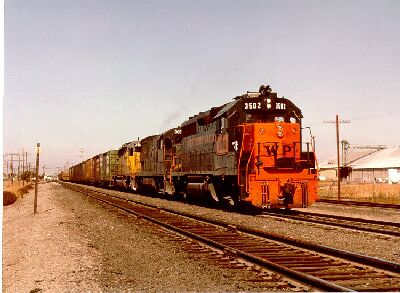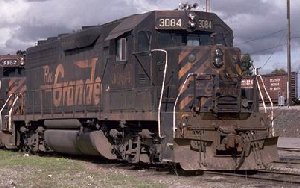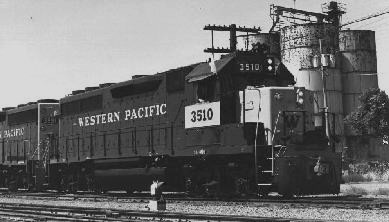
WP 3502 was WP's second GP40, being part of the initial order of 10 units. Seen here on the CCVX, 3502 is just starting its westward trek to Oakland at Ortega, just south of Stockton Yard on the First Subdivision. The 3502 has already been rebuilt by Morrison/Knudsen as witnessed in this August 1982 photograph; spotting features are the air conditioning box on top of the cab and the New Image paint. (Ken Rattenne Photo)

Rio Grande's was the only western
road to roster more GP40s than the WP. And like the WP, ordered the model's
successor, the GP40-2. In
1997 there is still a large number of Grande '40s in original colors. Above,
GP40-2 3084 at Warm Springs (Fremont) CA. (Ken
Rattenne photo)
|
EMD debuted the GP40 in the fall of 1965 as part of a new catalog of models based on their new 645 diesel prime mover. WP's interchange partner Rio Grande ordered 13 units sight unseen, taking delivery in January of 1966. On the strength of the Grandes' word, WP ordered 10 locomotives of its own for a May 1966 delivery. Trade-ins for these units were a like number of worn-out FT A and B-covered wagons.
As scheduled, in May of 1966 WP took delivery of GP40s 3501-3510. The units were basically "off the shelf: While similar in appearance to the GP35 (which was the first road unit manufactured in any quantity to feature EMD's new "boxy" look) the trucks were spaced two feet further apart, allowing for a 3,600 gallon fuel tank (1,000 gallons more than the GP35s). In addition, the dynamic brake blister was longer and the three exhaust fans on the topside of the long hood were all of the same diameter.
The power plant of each unit featured EMD's 16-cylinder turbo-charged 645E3 prime mover powering four D77 traction motors, which the railroad liked enough to eventually standardize on for all its power. One "customized" feature was the headlight: WP preferred These units leaned heavily on parts credits from traded-in FT and F7 units.
The most obvious surviving component from the "covered wagons" were
the trucks, which were rebuilt and upgraded with the D77 traction motor,
saving WP a significant amount of money in the process. Also, the
Pyle-National headlights from the units were also utilized, which consisted
of a single large bulb and reflector.
